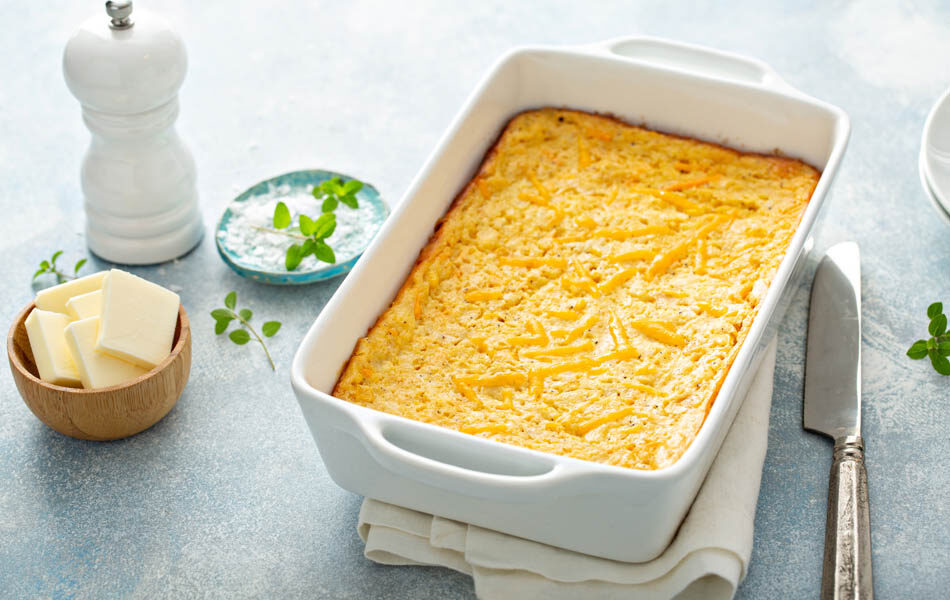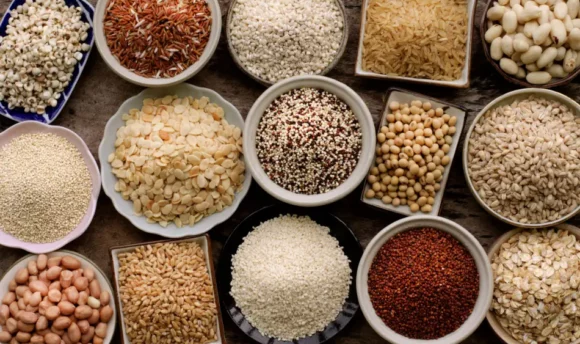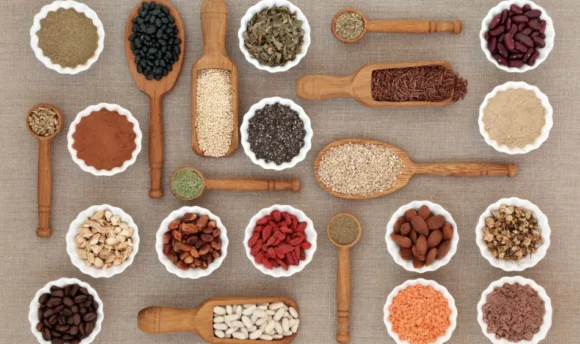Is Cornbread Healthy? Nutrition, Calories, and Benefits
Cornbread is a popular starch option made from cornmeal and often served with chili or barbecue. However, it has some health implications.

Do you enjoy a piece of buttered and sweet cornbread with your stews, barbecue, or soups? Have you ever wondered if cornbread is good or bad for you?
Cornbread is a beloved side dish that is most often enjoyed in the Southern parts of the United States. It is usually served topped with butter or honey.
From the benefits, such as fiber content, to the downsides, such as sodium levels, let’s dive into more information regarding eating cornbread. Read on to learn more!
What Is Cornbread?
Cornbread is a variety of starch made from cornmeal or ground corn. It is often baked in the oven in a cast iron skillet and served topped with honey, butter, or jam.
Cornbread has a short and crumbly texture with coarse granules from the cornmeal. As cornbread is relatively dry to eat plain, it is best eaten with chili or soup.
It is traditionally uniform throughout; however, many add fresh corn kernels for more texture.
Is Cornbread Healthy?
Cornbread is not a healthy starch choice because it is relatively low in beneficial nutrients, such as most vitamins and minerals. However, it is high in fat, calories, and sodium.
5 Types of Cornbread
There are actually more than five different types of cornbread. Whether you prefer the traditional cornbread or are looking to brand out something new, let’s talk about the five most common types of cornbread!
#1 Traditional oven-baked cornbread
The first type of cornbread is what you think of in your mind when you typically imagine cornbread. Traditional crumbly and moist quick bread cornbread that is baked in the oven, often in a cast iron skillet for even heat distribution.
This cornbread can have whole-corn kernels or could just be made from cornmeal. It is perfect topped with warm butter or honey.
#2 Johnny cakes
Johnny cakes are similar in ingredients to regular cornbread in that they do not contain leaveners, such as baking powder.
Labeled as the “cornbread flatbread,” Johnny cakes are often cooked on a griddle just like pancakes. However, they can be baked in the oven as well.
#3 Cracklin’ bread
Next up is cracklin’ bread, which is popular in the American South. Cracklin’ bread is just as it sounds, cornbread with cracklings added in.
What are cracklings? They are rendered down pork fat that adds a lot of savory flavor to the cornbread.
It is important to note that adding cracklings will significantly increase the fat content, especially saturated fat, of your cornbread. It will also increase dietary cholesterol levels, which can contribute to an increased risk of heart disease.
#4 Corn pone
Corn pone is a dense and unleavened variation of cornbread that is much heavier and less fluffy. It is baked in the oven on a cast iron skillet.
Corn pone has more of an irregular look to it as it is formed in flat oval shapes or loaves. It often includes bacon drippings and fat, which gives it a rich flavor and texture.
Unfortunately, bacon and other red meats can contain very small amounts of a very dangerous type of fat called trans fat. According to the United States Department of Agriculture FoodData Central, a 100g serving of bacon contains 0.15g of trans fat.
While this may seem insignificant, the 2020–2025 Dietary Guidelines for Americans recommends consuming as little trans fat as possible since it has been shown to be very harmful to human health.
Therefore, in a diet high in red meat and processed meats, the trans fat can add up quickly.
#5 Hot water cornbread
Finally, hot water cornbread is a delicious type of bread that is formed into balls and fried on the stove. They are typically served with maple syrup or honey.
Despite its name of “Hot Water” cornbread, this variation of the classic cornbread is also fried in bacon grease. Since this can also increase the saturated fat and trans fat content of cornbread, it is best to only eat these in moderation and in small amounts.
5 Benefits of Cornbread
Let’s talk about the pros of eating cornbread and how it can be beneficial to your nutrition and health.
#1 Source of protein
First of all, cornbread does contain a small amount of protein. According to the United States Department of Agriculture (USDA) FoodData database, a 100g serving of cornbread contains almost 7g of protein.
Pair it with turkey chili, a meaty soup, or a sandwich to add more protein.
Protein is made up of essential amino acids that work together to facilitate every chemical reaction in the body. Protein also helps build and repair muscles, especially for athletes, pregnant and breastfeeding women, and children.
#2 Supports strong bones
Cornbread contains 135mg of calcium and 391mg of phosphorus in a 100g serving. This is mainly from the milk or cream used in the bread.
According to Calcium and Phosphorus Homeostasis, calcium and phosphorus work together in the bone mineralization process.
To continue to support strong bones, pair your cornbread with a glass of milk.
A swap that would increase calcium and phosphorus is using Greek yogurt instead of butter (hint: this would also greatly increase the protein, probiotics, and lower the fat of your bread!) – for more information on this, check out the healthy cornbread recipe below!
#3 Contains antioxidants, such as selenium
A 100g serving of cornbread contains 8.7μg of selenium. While this is a small amount, selenium is an antioxidant that helps protect cells from free radicals in the body.
The body naturally produces harmful free radicals as a by-product of processes such as energy metabolism, where food is broken down for fuel.
However, a diet high in antioxidants can balance out the effects of free radicals and combat inflammation and oxidative stress. Inflammation plays a role in many chronic disease states, such as obesity, diabetes, and heart disease.
#4 Rich in dietary fiber
A benefit of cornbread is its fiber content. A 100g serving contains 2.3g of dietary fiber.
While this may not seem like much, getting small amounts of fiber in during your day can add up fast!
According to the Mayo Clinic, dietary fiber is important in your diet for regulating bowel movements, controlling blood sugar, and lowering blood cholesterol levels.
Fiber slows down the absorption of sugar and prevents blood sugar spikes.
Additionally, fiber helps you feel full and satisfied after a meal.
Since cornbread typically contains only cornmeal and white all-purpose flour, adding in some whole-wheat flour can increase the fiber content and, therefore, the nutritional benefits.
#5 Source of iron
While a small amount, the cornmeal in cornbread does contain some iron from the cornmeal.
According to the National Institutes of Health (NIH), iron is essential for oxygen transport through red blood cells to help move oxygen to cells all around the body. Iron is also good for muscle growth and connective tissue health.
Pair your cornbread with a source of vitamin C, such as bell peppers, citrus fruits, or tomatoes. Vitamin C works in the body to help absorb iron more readily and efficiently.
5 Side Effects of Cornbread
Now that we have discussed the benefits of cornbread, it only makes sense to mention its downsides or side effects. So let’s get into it.
#1 Very high in fat, including saturated fat
Many store-bought cornbread mixes and homemade cornbread are made with butter or shortening. These products are high in saturated fat, a type of fat that can be dangerous when consumed in excess.
Saturated fat consumption can contribute to an increased risk of heart disease, including heart attack and stroke. Of course, it can also lead to weight gain, which increases the risk of many other disease states as well.
If animal fat is used, such as bacon grease or cracklings, as mentioned above, there could even be some trans fat in the cornbread. Trans fat is very dangerous for the heart, so it is best to avoid cornbread made with animal fat. It is also not keto-friendly.
#2 High in sodium
Another downside of cornbread is its high sodium content. According to the USDA database, a 100g piece of cornbread contains a whopping 599mg of sodium.
The American Heart Association recommends that you should consume no more than 2,300mg of sodium for your whole day. However, they say it is even more ideal to have just 1,500mg.
You are at over a quarter of the maximum allowed sodium for this small piece of cornbread for your entire day.
Consuming too much salt can make you thirsty and dehydrated and increase your risk of developing heart diseases, such as high blood pressure or hypertension, heart attack, and stroke.
According to the International Journal of Molecular Sciences, a diet high in sodium can also contribute to heart failure, kidney disease, and other comorbidities.
#3 High energy density
Additionally, cornbread is an energy-dense food. This means it has low nutrition for the number of calories it contains. Although cornbread has some vitamins, minerals, and fiber – as mentioned above – they are in relatively small amounts.
To increase the nutrient density of your cornbread, use whole-wheat flour, which is rich in fiber, protein, and many other beneficial nutrients. Additionally, pair your cornbread with fresh vegetables and fruits that add nutrition as well as flavor.
#4 Boxed mixes can be high in sugar
Another potential downside of cornbread is that many of the store-bought mixes found in the baking aisle of your favorite grocery store are high in sugar.
Always check the nutrition facts label to look for lower sugar options to reduce your added sugar intake. Try to aim for less than ten grams of added sugar in a serving – around 5g is even more ideal!
Excessive consumption of added sugars can contribute to weight gain, obesity, and diabetes.
#5 Contains white flour
Cornbread is typically made with refined flour, such as all-purpose white flour. This flour, enriched with B vitamins, is much lower in vitamins, minerals, fiber, and protein than whole-wheat flour.
For more information about substituting whole-wheat flour in your cornbread, check out the healthy cornbread recipes below!
Cornbread Nutritional Facts
Now that we have covered the benefits and potential side effects and downsides of eating cornbread, let’s dive into more information about the nutrition facts.
Nutritional table (per 100g)
| Calories/Nutrient (per 100g) | Amount |
| Calories (kcal) | 330 |
| Sodium (mg) | 599 |
| Net Carbs (g) | 54.5 |
| Fiber (g) | 2.3 |
| Sugar (g) | 16 |
| Fats (Total) | 9.58 |
| Protein (g) | 6.59 |
| Cholesterol (mg) | 57 |
Source: https://fdc.nal.usda.gov/fdc-app.html#/food-details/1100844/nutrients
High in carbohydrates
Since cornbread contains cornmeal and often enriched all-purpose flour as well, cornbread is high in carbohydrates. They have about 55g of carbohydrates in a 100g serving.
Therefore, it is best to consume cornbread in moderation and just have a small amount because too many carbohydrates can be stored in the body as fat and continue to weight gain.
High in vitamins and minerals
A benefit of cornbread is that it does contain some essential vitamins and minerals from the cornmeal, such as phosphorus, B vitamins, and iron.
We covered some of these vitamins and minerals above in the benefits of cornbread. However, certain ingredients can add even more vitamins and minerals.
For example, swapping the butter for greek yogurt can significantly increase calcium and vitamin D content.
Low in cholesterol
While it is not cholesterol-free, cornbread just contains a small amount of cholesterol. For example, a 100g serving of cornbread has 57mg of cholesterol.
Cholesterol is a waxy type of fat that is naturally made in the liver. Since our livers make all the cholesterol that is needed to survive, there is no nutritional need to consume it in the diet.
Animals also make cholesterol in their liver, so animal products often contain cholesterol. Too much cholesterol in the diet can increase the risk of heart disease, including heart attack and stroke.
However, foods that are a part of a healthy and balanced diet, such as lean meats and low-fat dairy, are animal products and, therefore, contain some cholesterol. Therefore, eating these healthy foods is still advised, even though they have some cholesterol.
The 2020–2025 Dietary Guidelines for Americans recommend consuming as little dietary cholesterol as possible while maintaining a healthy diet.
According to the Mayo Clinic, dietary fiber can help lower blood cholesterol levels, especially when you eat soluble fibers found in oats, flax, and beans.
High in calories and fats
Unfortunately, a 100g piece of cornbread is relatively high in calories and fat, with 330 calories and almost 10g of fat.
The butter and fat added to the cornbread to give the bread its signature coarse texture we all love is what contributes to the high caloric density.
Excess calories and fat in the diet can contribute to undesirable weight gain and obesity.
Therefore, just stick with eating cornbread in moderation.
High in added sugars
Many cornbread recipes, especially those made from boxed mixes, are high in added sugars as well. Many recipes call for up to a quarter of a cup or even more of white granulated sugar.
Excess added sugars can quickly add up when you have a few pieces of cornbread and contribute to potential weight gain and obesity. Therefore, substituting white sugar with honey is the best alternative.
While honey is still considered a sugar, it is a natural sugar that also provides many nutrients from the honey itself.
Healthy Cornbread Recipe
Now let’s talk about how to make a simple and versatile cornbread that is both healthy and better than the boxed mix!
Ingredients:
- 1 cup cornmeal
- ⅔ cup refined all-purpose flour
- ¼ cup whole-wheat flour
- 3 tsp baking powder
- 1 tsp iodized salt
- 1 cup nonfat milk or 1% milk (can substitute non-dairy milk alternatives, such as soy milk or almond milk)
- ¼ cup honey
- ¼ cup nonfat or low-fat Greek yogurt
- ¼ cup whole, fresh corn kernels (optional)
Instructions:
1. In a large bowl, combine the corn meal with refined flour or all-purpose flour and whole wheat flour.
2. Add the baking powder and salt. Baking powder is a leavening agent that helps ensure a fluffy cornbread.
3. Mix up the dry ingredients well.
4. In a separate bowl, mix together the milk or non-dairy milk alternative, honey, and greek yogurt. Combine well.
Honey is a great natural substitute for brown sugar or white sugar. The brown or white sugar can add unwanted calories and carbohydrates.
Additionally, greek yogurt is a great replacement for unsalted butter.
If you prefer savory cornbread, use less honey and opt for unsweetened yogurt. Savory cornbread can even be seasoned with more spices, such as chili powder.
5. Fold in the dry ingredients with the wet mixture until well-combined.
You could even add in some fresh corn kernels as well. Corn kernels can add even more fiber and nutrition to the meal.
6. Now, pour the mixture into a cast iron skillet and pop it in the oven.
Instead of a cast iron skillet, you can also use a regular baking pan. However, a cast iron skillet distributes the heat well for even cooking.
7. Bake at 400ºF until cooked through. This will take approximately 20–30 minutes. Let it cool slightly, cut, serve, and enjoy!
If you want to check more healthy recipes we would recommend DoFasting Nutrition App.

- 5,000+ healthy recipes
- Healthy desserts
- Improved eating habits
- Calorie tracker to track daily caloric intake
- Full guidance on successful diet
FAQs
Cornbread is unhealthy for you because it is typically high in sodium and fat and low in nutrition. It also can contain animal fat, which is dangerous for the heart.
It is not okay to eat cornbread every day because it can contribute to weight gain, heart disease, and more. Consume cornbread in moderation only.
Cornbread is not suitable for weight loss because it is high in fat, especially saturated and even trans fat.
Since cornbread is a starch and is typically high in butter or shortening, it can contribute to fat gain and weight gain.
By definition, cornbread is made from cornmeal or ground corn. However, it can have whole corn kernels in it as well.
A Word From a Nutritionist
Overall, cornbread is a starch best consumed infrequently. Instead, choose more nutrient-dense choices such as whole-grain bread, brown rice, or wheat pasta.
These alternatives will offer more protein, dietary fiber, vitamins, and minerals for the number of calories they contain. In other words, they are more nutrient-dense when compared to cornbread, which is more energy-dense.
There are many ways to improve your cornbread’s nutrition if you choose to have it.
Make it homemade to control exactly how much sodium you add. Store-bought mixes or ready-made bread can be very high in salt.
Additionally, opt for cornbread recipes that eliminate any added fats from oils and instead use yogurt to get that signature texture.
Conclusion
In conclusion, cornbread is unhealthy because of its low nutritional value compared to whole wheat bread, brown rice, or wheat pasta, for example.
However, it does have some benefits, such as small amounts of iron, phosphorus, and B vitamins. On the other hand, these vitamins and minerals can be found in other healthier foods in more significant amounts, without the high amounts of fat and sodium.
Additionally, cornbread is often homemade using animal fats, which can contribute to unhealthy amounts of saturated fat and even trans fats.
Overall, stick with whole grain starch options and just have a small piece of cornbread in moderation.

















































 Select your language:
Select your language: 








